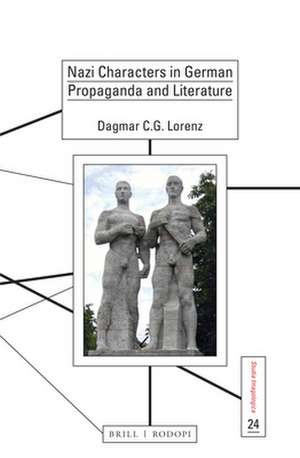Nazi Characters in German Propaganda and Literature: Studia Imagologica, cartea 24
Autor Dagmar C. G. Lorenzen Limba Engleză Hardback – 4 iul 2018
Stereotypical characters that promoted the Nazi worldview were repurposed by antifascist authors in Weimar Germany, argues Dagmar C.G. Lorenz. This is the first book to trace Nazi characters through the German and Austrian literature. Until the defeat of the Third Reich, pro-Nazi literature was widely distributed. However, after the war, Nazi publications were suppressed or even banned, and new writers began to dominate the market alongside exile and resistance authors. The fact that Nazi figures remained consistent suggests that, rather than representing real people, they functioned as ideological signifiers. Recent literature and films set in the Nazi era show that “the Nazis”, ambiguous characters with a sinister appeal, live on as an established trope in the cultural imagination.
Preț: 506.10 lei
Preț vechi: 595.41 lei
-15% Nou
Puncte Express: 759
Preț estimativ în valută:
96.85€ • 105.17$ • 81.36£
96.85€ • 105.17$ • 81.36£
Carte indisponibilă temporar
Doresc să fiu notificat când acest titlu va fi disponibil:
Se trimite...
Preluare comenzi: 021 569.72.76
Specificații
ISBN-13: 9789004365254
ISBN-10: 9004365257
Dimensiuni: 155 x 235 mm
Greutate: 0.54 kg
Editura: Brill
Colecția Brill
Seria Studia Imagologica
ISBN-10: 9004365257
Dimensiuni: 155 x 235 mm
Greutate: 0.54 kg
Editura: Brill
Colecția Brill
Seria Studia Imagologica
Notă biografică
Dagmar C. G. Lorenz, Ph.D. (1974), Cincinnati, is Professor Emerita in German, University of Illinois-Chicago. She has published monographs, editions, and articles in Austrian and German Studies, including Keepers of the Motherland: German Texts by Jewish Women Writers (1997).
Recenzii
"Lorenz’s critical powers are on display in her social analysis and diagnoses of characters in German works published from 1920 to 1950."
-R. C. Conrad, University of Dayton, US, in: CHOICE, Vol. 56, No. 5
"The importance of this much-needed study cannot be overstated, especially today when the reemergence of repressive nationalistic regimes are on the rise throughout the world."
-Steven R. Cerf, Bowdoin College, in: Journal of Austrian Studies, Vol. 52, Iss. 3, pp. 105-108
-R. C. Conrad, University of Dayton, US, in: CHOICE, Vol. 56, No. 5
"The importance of this much-needed study cannot be overstated, especially today when the reemergence of repressive nationalistic regimes are on the rise throughout the world."
-Steven R. Cerf, Bowdoin College, in: Journal of Austrian Studies, Vol. 52, Iss. 3, pp. 105-108
Cuprins
Acknowledgments
Introduction
1 The Origins and Conceptualization of Nazi Figures after the First World War
The Utopian Typology of a Nazi State and Its Citizens
The Program of the National Socialist German Workers’ Party
Artur Dinter’s Anti-Semitic Novel Die Sünde wider das Blut
Hans F.K. Günther’s Racial Theory in Rassenkunde des deutschen Volkes
Adolf Hitler’s Autobiographical Manifesto Mein Kampf
Alfred Rosenberg’s Racialized Cultural History Der Mythus des Zwanzigsten Jahrhunderts
Critical Responses to the Nazi Typology
Hans Reimann’s and Hugo Bettauer’s Political Satires
Joseph Roth’s Society Novel Das Spinnennetz
Gertrud Kolmar’s Novella Die Jüdische Mutter
2 Contested Nazi Characters
Literature Exploring the Turning Point of 1932/3 through Nazi Figures
Lion Feuchtwanger’s Family Saga Die Geschwister Oppenheim
Ferdinand Bruckner’s Drama Die Rassen
Friedrich Wolf’s Drama Professor Mamlock
Transfigured Germans. Leni Riefenstahl’s Celebration of the National Community in the Propaganda Film Triumph des Willens
Representations of Nazi Characters in Exile Literature
Hermynia Zur Mühlen’s Novel Unsere Töchter, die Nazinen
Klaus Mann’s Roman á Clef Mephisto
Bertolt Brecht’s Epic Drama Furcht und Elend des Dritten Reiches
Veza Canetti’s Novel Die Schildkröten
Anna Seghers’s Narrative Der Ausflug der toten Mädchen
3 The Problem of Nazi Identity and Representation after 1945
Processing Defeat
The Memoir of Auschwitz Commandant Rudolf Höß
Marta Hillers’s Anonymous Memoir Eine Frau in Berlin
Ingeborg Bachmann’s Wartime Diary Kriegstagebuch
Writing about Nazis—A Postwar Dilemma
Carl Zuckmayer’s Drama Des Teufels General
Wolfgang Borchert’s Play Drauβen vor der Tür
Heinrich Böll’s Narrative Der Zug war pünktlich
Ilse Aichinger’s Novel Die gröβere Hoffnung
Conclusion
Bibliography
Index
Introduction
1 The Origins and Conceptualization of Nazi Figures after the First World War
The Utopian Typology of a Nazi State and Its Citizens
The Program of the National Socialist German Workers’ Party
Artur Dinter’s Anti-Semitic Novel Die Sünde wider das Blut
Hans F.K. Günther’s Racial Theory in Rassenkunde des deutschen Volkes
Adolf Hitler’s Autobiographical Manifesto Mein Kampf
Alfred Rosenberg’s Racialized Cultural History Der Mythus des Zwanzigsten Jahrhunderts
Critical Responses to the Nazi Typology
Hans Reimann’s and Hugo Bettauer’s Political Satires
Joseph Roth’s Society Novel Das Spinnennetz
Gertrud Kolmar’s Novella Die Jüdische Mutter
2 Contested Nazi Characters
Literature Exploring the Turning Point of 1932/3 through Nazi Figures
Lion Feuchtwanger’s Family Saga Die Geschwister Oppenheim
Ferdinand Bruckner’s Drama Die Rassen
Friedrich Wolf’s Drama Professor Mamlock
Transfigured Germans. Leni Riefenstahl’s Celebration of the National Community in the Propaganda Film Triumph des Willens
Representations of Nazi Characters in Exile Literature
Hermynia Zur Mühlen’s Novel Unsere Töchter, die Nazinen
Klaus Mann’s Roman á Clef Mephisto
Bertolt Brecht’s Epic Drama Furcht und Elend des Dritten Reiches
Veza Canetti’s Novel Die Schildkröten
Anna Seghers’s Narrative Der Ausflug der toten Mädchen
3 The Problem of Nazi Identity and Representation after 1945
Processing Defeat
The Memoir of Auschwitz Commandant Rudolf Höß
Marta Hillers’s Anonymous Memoir Eine Frau in Berlin
Ingeborg Bachmann’s Wartime Diary Kriegstagebuch
Writing about Nazis—A Postwar Dilemma
Carl Zuckmayer’s Drama Des Teufels General
Wolfgang Borchert’s Play Drauβen vor der Tür
Heinrich Böll’s Narrative Der Zug war pünktlich
Ilse Aichinger’s Novel Die gröβere Hoffnung
Conclusion
Bibliography
Index












